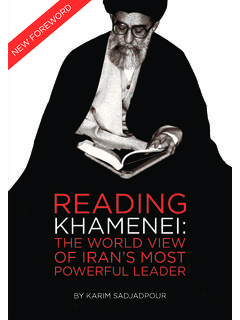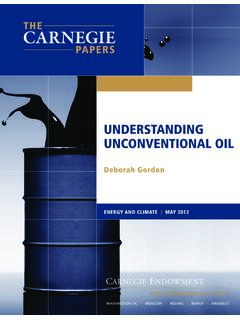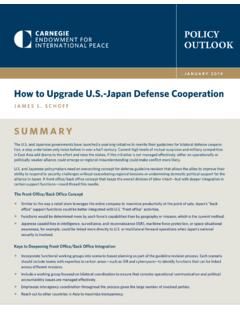Transcription of The Taliban's Winning Strategy in Afghanistan
1 THE TALIBAN SWINNING Strategy IN AFGHANISTANGILLES DORRONSOROThe Taliban s Winning Strategy in AfghanistanGilles Dorronsoro 2009 Carnegie Endowment for International Peace. All rights part of this publication may be reproduced or transmitted in any form or by any means without permission in writing from the Carnegie Carnegie Endowment normally does not take institutional positions on public policy issues; the views represented here do not necessarily reflect the views of the Endowment, its staff, or its electronic copies of this report, visit image: Taliban Chief Mullah Omar, Getty ..4 Summary ..5 Introduction.
2 7 Taking the Taliban Seriously ..9 How the Taliban Build Support Over Social Grievances ..12 Dealing With Ethnicity ..13 The Resentment Against the IC: From Mehman to Dushman ..16 The Vacuum in Local Governance ..17 The Regional Fronts and the Global Strategy ..20 Sanctuary and Roads ..2 1 Consolidating the Insurgency s Grip in the South and East ..24 Opening a Northern Front ..27 The Situation Around Greater Kabul ..28 Conclusion: Why the Current Strategy Is Not Efficient ..29 References ..31 Table of ConTenTsaCknowleDGmenTsThanks to Ashesh Prasann, George Perkovich, and Nicole Watts for their careful editing of the first draft.
3 This study was written after a trip to Afghanistan (Kabul, Gardez, Jalalabad, Mazar-i Sharif, Kunduz, and Uruzgan) in April 2009. I am sincerely grateful to the people who were kind enough to share their time and information. Among them were Oliver Vick, Sergiy Sobistiyanskyy, Christophe Sivillon, Vikram Parekh, Guillame Limal (UNAMA); Ehsan Zahine, Fr d ric Lamy, and Masood Karokhel (TLO), Major Thomas Jacob, Lt. Col. Daniel R. Roy (American PRT in Gardez); Lorenzo Deslegues (Transparency), Claire Billet and Luc Mathieu (journalists); Scott Bohlinger (Anso) in Mazar-i Sharif, and all those who under the current conditions prefer to remain anonymous.
4 I also wish to thank the DAFA (Philippe Marquis, Roland Besenval, and Nicolas Engel) for their friendly, if spartan, accommodation. SummaryA misunderstanding of the insurgency is at the heart of the difficulties facing the International Coalition in Afghanistan . The Taliban are often described as an umbrella movement comprising loosely connected groups that are essentially local and unorganized. On the contrary, this report s analysis of the structure and Strategy of the insurgency reveals a resilient adversary, engaged in strategic planning and coordinated action. The Taliban are a revolutionary movement, deeply opposed to the Afghan tribal system and focused on the rebuilding of the Islamic Emirate.
5 Their propaganda and intelligence are efficient, and the local autonomy of their commanders in the field allow them both flexibility and cohesion. They have made clever use of ethnic tensions, the rejection of foreign forces by the Afghan people, and the lack of local administration to gain support in the population. In so doing the Taliban have achieved their objectives in the South and East of the country, isolating the Coalition, marginalizing the local Afghan administration, and establishing a parallel administration (mainly to dispense Sharia justice and collect taxes). In recent months, a more professional Taliban have succeeded in making significant inroads by recruiting from non-Pashtun communities.
6 These developments, and the strength of the insurgency makes the current Coalition Strategy of focusing its reinforcements in the South (Helmand and Kandahar) unwise to say the least. The lack of local Afghan institutions there will require a long term presence and therefore a need for even more reinforcements in the coming year. Meanwhile, the pace of Taliban progress in other provinces (see map, inside front cover) far outstrips the ability of the Coalition to stabilize the South. The Coalition should change the priorities of its current Strategy , shifting resources to stop and reverse the Taliban s progress in the North, while reinforcing and safeguarding the Kabul region or risk losing control of the entire country.
7 IntroductionThe situation in Afghanistan continues to deteriorate; the Taliban-led insurgency retains control of the strategic initiative, and the International Coalition (IC) lacks clear direction. The insurgency has made significant inroads in the past months, consolidating its grip in the South and East, securing its sanctuary in Pakistan, and opening new fronts in the North. The situation around Kabul is unclear. Taliban leaders are now convinced that the International Coalition will soon be compelled to accept the facts on the ground and abandon Afghanistan in a few years. Since the Bush administration s departure, the United States has tried to develop a Strategy for defeating the Taliban.
8 Nonetheless, the recent initiatives lack coherence and do not offer a credible response to the advance of the insurgency. Worse, while some measures are useful, others are potentially dangerous and could very well accelerate the pace at which the Taliban gain ground. The biggest mistake is to concentrate reinforcements in the South, while failing to react quickly and decisively to stop Taliban inroads in the North, where success now would be readily achievable. The Taliban s strength explains why the reinforcements sent in 2009 (21,000 troops) cannot beat the Taliban in their southern and eastern strongholds. Sealing the border would be politically difficult, and the burden of doing so would fall primarily on the United States.
9 In addition, it would take time, since the Taliban have the momentum. Defeating the Taliban would require at least 100,000 new reinforcements as long as the Afghan Pakistani border remained open to insurgents. Neither the United States nor NATO is willing or able to pay the human and fiscal costs of reinforcements at this level. Even if they were, sealing the border would be extremely difficult in political and military terms CA R N E G I E EN D OWM E N T FO R IN T E R N AT I O N A L PE AC E8 | The Taliban s Winning Strategy in Afghanistan Gilles Dorronsoroand would take considerable time. There would also be a risk of the situation in the North deteriorating significantly in the meantime.
10 Indeed, under the current Strategy of concentrating new forces in the South and East, the Taliban will move the insurgency to the North. One of the key reasons for the lack of a productive IC Strategy is the IC s and broader western misperception of the Taliban. They are often characterized as backward, medieval, and reactionary, and as an association of loosely organized groups. The insurgency is perceived as a local problem to be solved locally; the national and dynamic dimension of the struggle is not taken into account. In fact, the Taliban are quite capable of strategic planning and coordinated action. This means that they will adapt to and counter any moves by the International Coalition.









